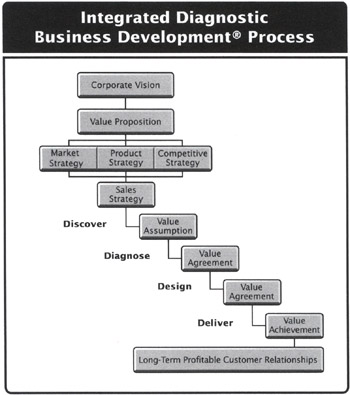
|


|
An Integrated Business Development Map
Now that we've talked about the prerequisites necessary to successfully execute a go-to-market strategy and the mechanisms that create them, we can take a high-altitude look at the way in which a go-to-market strategy is achieved. This sequence of events that forms a path from the corporate vision and value proposition to the ultimate goal of a business - the establishment of profitable, loyal, long-term customer relationships, is called the Integrated Business Development (IBD) Map; its flow is illustrated in Figure 9.1.
The IBD Map is focused on the creation of value. An organization's concept of value grows out of its vision. This vision provides the framework from which its corporate strategy evolves and a value proposition is derived. The value proposition, along with the products and services it generates, is delivered to the customer through a series of strategies that together comprise a go-to-market strategy.
The market strategy defines the marketplace in which the company will do business. It identifies the markets and market segments in which the company will sell its products and services. The competitive strategy defines a company's position with regard to other organizations within its market spaces. It identifies other companies vying for business in the same marketplaces, evaluates their strengths and weaknesses, and offers a plan to successfully compete against them. The product strategy defines the company's products and services. It determines how each will fit the particular market segment for which it is designed. Finally, sales strategy defines how the company's product and services will be offered to customers. The sales strategy is created at three levels: the customer or enterprise level, the opportunity level, and the individual or appointment level. It details the content and flow of the sales process and diagnostic strategy. The corporate value proposition is the cornerstone that supports each of the four strategies. The purpose of those strategies is to deliver the promise of the value proposition to market and, ultimately, to individual customers. The process unfolds through the same value sequence described at the end of Chapter 3: The value proposition is extended to the market, yielding assumptions about customers' situations and the ability of the company's offerings to address those issues; the value assumption is explored, yielding agreement about the problems being experienced and their best solutions; and the value agreement is delivered and, in turn, yields value achievement.
The IBD process is traveled twice in the creation and delivery of value. The first pass through the process occurs as each of the four strategies under the go-to-market umbrella is developed. In this way, a company can ensure that each element of its strategic plan for creating value is aligned to the needs of its prospective customers. We confirm that we can leverage value via the product, process, and performance levels of our customers organization. In other words, we want to be sure that our strategies are capable of delivering value during their planning stages before we devote the full resources of the organization to realizing them.
The second pass through the IBD process occurs during the execution of each of the four strategies. In this pass, a company ensures that each strategy actually works as planned and makes any necessary corrections in real time. In other words, we want to ensure that each strategy succeeds - that it fulfills the value proposition we are bringing to market and creates the expected value assumption, agreement, and achievement.
When the Integrated Business Development Process is successfully traversed, the go-to-market strategy is realized, value is delivered to customers and value is returned to the business in the form of increased margins. The by-product of this end result is the lifeblood of corporate success - long term, profitable customer relationships. The corporate vision has been transformed into bottom-line results.
The topics covered herein concern solution sales, consultative sales, and consultative selling.

|


|
